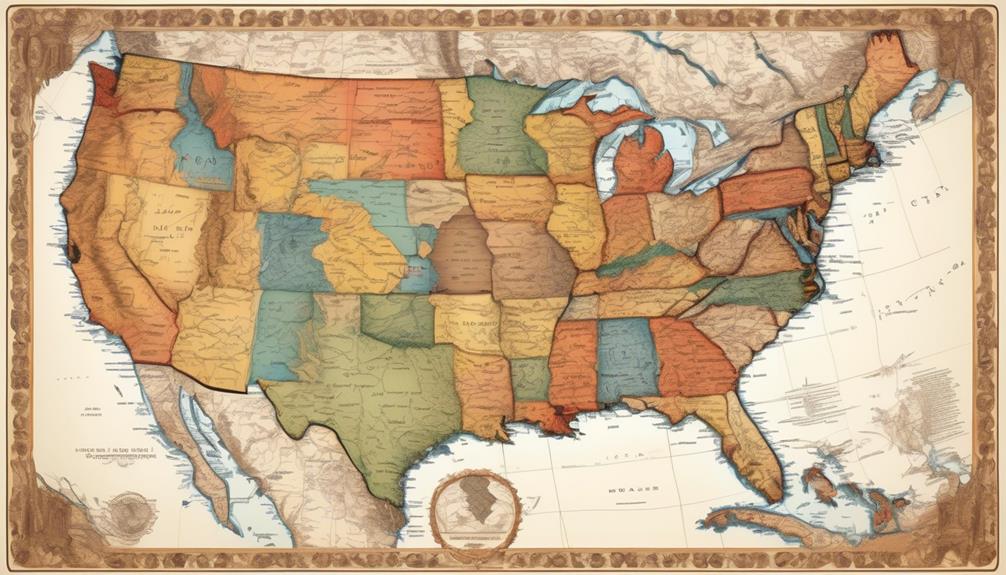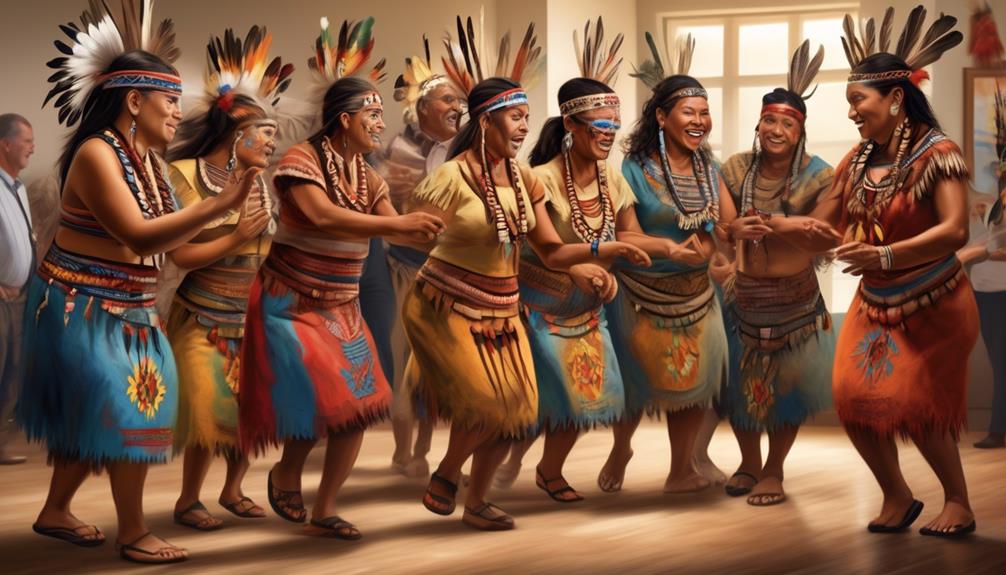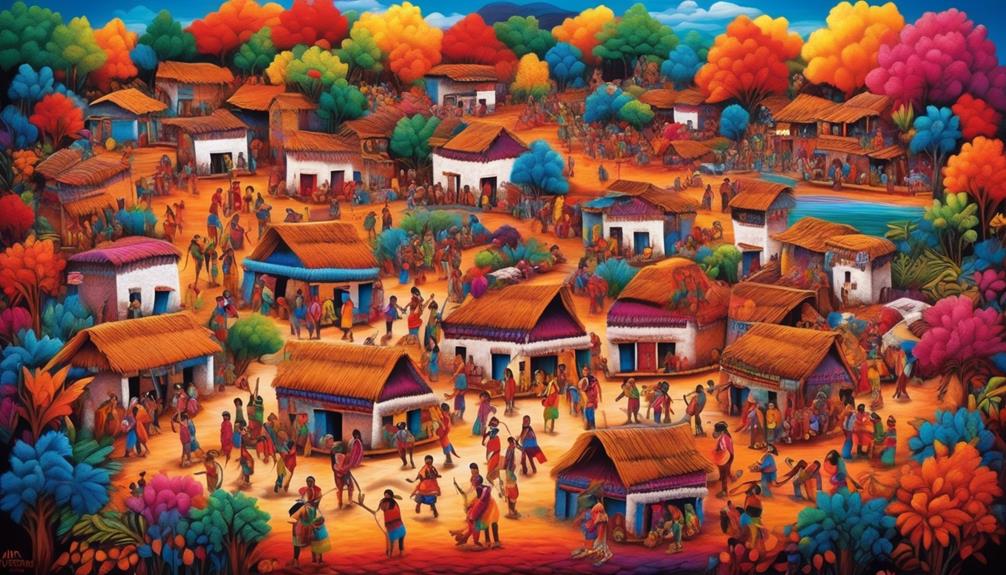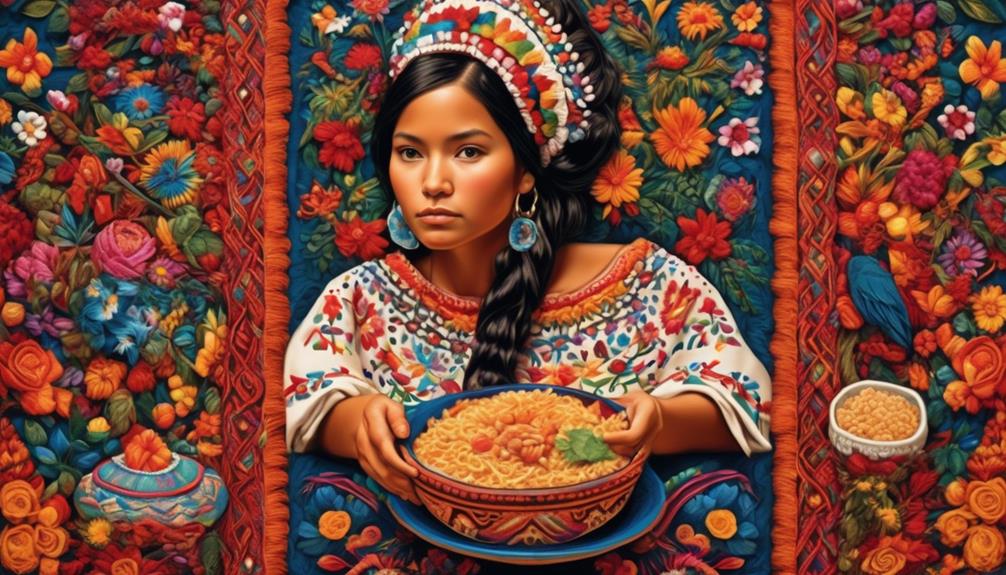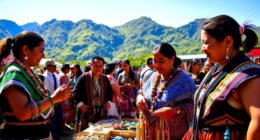Many people mistakenly believe that indigenous populations in Southeast Asia simply submitted to colonial rule without putting up a fight, but the reality is much more complex.
The responses of these communities were multifaceted, ranging from outright resistance to strategic collaboration.
The ways in which they navigated and contested colonial power continue to shape the region to this day.
Understanding these responses offers a nuanced perspective on the enduring impact of colonialism and the resilience of indigenous cultures.
Key Takeaways
- Indigenous people in Southeast Asia had diverse socio-political structures rooted in their indigenous cultures and traditions, including traditional leadership structures and local rulers or chiefs.
- Indigenous resistance movements played a crucial role in asserting autonomy and challenging colonial domination through armed uprisings, diplomatic negotiations, and cultural preservation efforts.
- Collaborative strategies and adaptation were important for indigenous communities in navigating colonial rule while maintaining their cultural heritage and autonomy, including forming alliances with neighboring groups, cultural syncretism, and economic diversification.
- The legacy of colonial rule continues to impact indigenous communities, resulting in unique cultural syncretism, adaptation of new systems of governance and social organization, and a lasting imprint on their contemporary realities.
Pre-colonial Socio-political Structures
Before the arrival of colonial powers, Southeast Asia exhibited a diverse range of socio-political structures that were deeply rooted in the indigenous cultures and traditions of the region. Socio-economic dynamics played a significant role in shaping these structures.
The region's economy was primarily agrarian, with trade networks connecting various communities. Traditional leadership structures were prevalent, often characterized by hierarchical systems with local rulers or chiefs exercising authority. These leaders were responsible for maintaining social order, resolving disputes, and overseeing economic activities.
The societal fabric was woven with customs, rituals, and community practices that upheld the collective well-being. These pre-colonial socio-political structures weren't homogenous, varying across different regions and ethnic groups. They reflected the rich tapestry of indigenous governance systems and social organization.
Understanding these dynamics is crucial in comprehending how colonial powers disrupted existing structures and reshaped the socio-political landscape of Southeast Asia. The impact of colonialism on these traditional structures and the subsequent responses of indigenous peoples form a critical aspect of the region's history.
Indigenous Resistance Movements
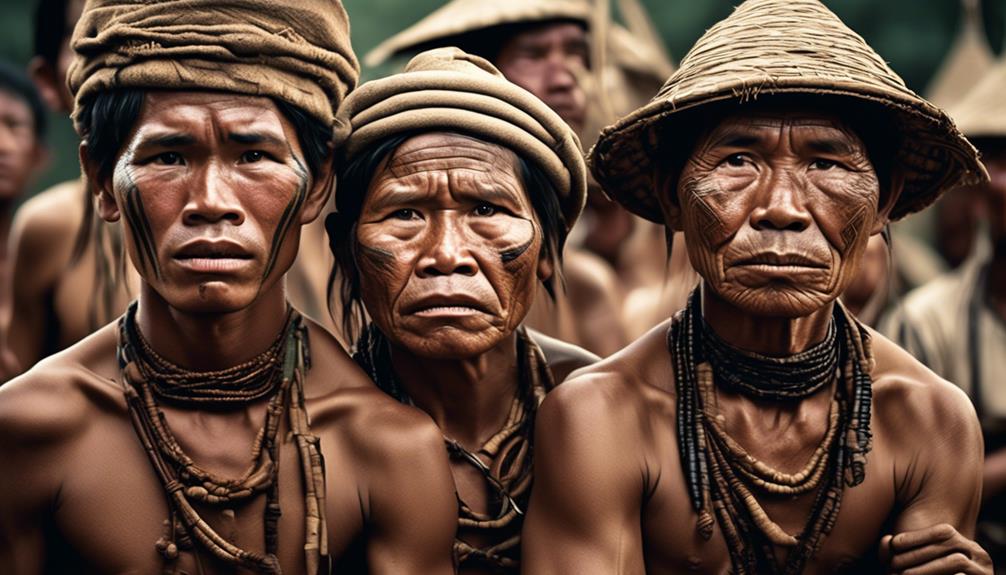
Indigenous communities across Southeast Asia actively resisted colonial rule through a variety of strategies, including armed uprisings, diplomatic negotiations, and cultural preservation efforts. These resistance movements were crucial in asserting indigenous autonomy and challenging colonial domination. The table below provides a snapshot of some key armed resistance movements and cultural preservation efforts in Southeast Asia during the colonial period.
| Armed Resistance Movements | Leaders/Key Figures | Outcome |
|---|---|---|
| Philippine Revolution | Andres Bonifacio | Independence from Spain |
| Aceh War | Teuku Umar | Dutch recognition of Aceh's sovereignty |
| Burmese Revolt | Saya San | Suppression by the British |
| Vietnamese Revolt | Nguyen Ai Quoc | French Indochina colonization |
| Dayak Uprisings | Rentap | Retained autonomy in parts of Borneo |
Cultural preservation efforts also played a significant role in resisting colonial rule. Indigenous communities safeguarded their cultural practices, languages, and traditional knowledge, which not only preserved their identity but also served as a form of resistance against colonial attempts to impose cultural hegemony. These efforts were essential in maintaining indigenous resilience and resistance in the face of colonial pressures.
Collaborative Strategies and Adaptation
Despite facing significant challenges, indigenous communities in Southeast Asia actively engaged in collaborative strategies and adapted their traditional practices to navigate the complexities of colonial rule. Collaborative resistance and adaptation strategies were essential for indigenous groups to maintain their cultural identity and autonomy while interacting with colonial powers.
- Alliances and Unity: Indigenous communities formed alliances with neighboring groups and sometimes even with other ethnicities to collectively resist colonial encroachment. Unity allowed them to pool resources, share knowledge, and present a more formidable front against colonial authorities.
- Cultural Syncretism: Indigenous communities strategically integrated certain aspects of colonial culture into their traditional practices, creating a form of cultural syncretism. By doing so, they navigated the colonial system while preserving their core cultural values and customs.
- Economic Diversification: In response to the economic changes brought by colonial rule, indigenous groups diversified their economic activities. They adapted by engaging in new forms of trade, agriculture, and labor to mitigate the impact of colonial economic policies and maintain some level of autonomy.
These collaborative and adaptive strategies were crucial in enabling indigenous communities to navigate the challenges of colonial rule while preserving their cultural heritage and autonomy.
Impact on Cultural Identity
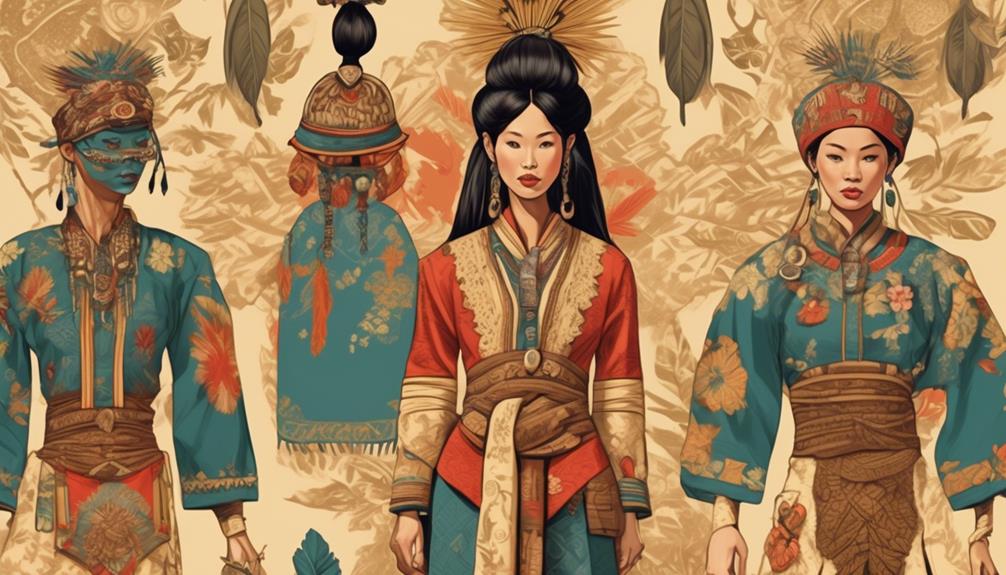
Navigating the complexities of colonial rule through collaborative strategies and adaptation, indigenous communities in Southeast Asia grappled with the profound impact on their cultural identity. The process of cultural assimilation, driven by colonial policies, posed a significant challenge to the preservation of traditional practices and beliefs. The imposition of Western education, legal systems, and religion often led to the erosion of indigenous cultural identity. Traditional practices, deeply rooted in the fabric of indigenous societies, faced suppression or distortion under colonial influence.
The impact on cultural identity was multifaceted, as it extended beyond tangible customs to encompass the intangible aspects of indigenous heritage. Language, spiritual beliefs, and social structures all underwent transformation, thereby disrupting the interconnected elements that defined the cultural identity of these communities. This disruption not only affected the present but also had lasting implications for future generations.
Despite these challenges, indigenous communities demonstrated resilience by selectively adopting certain elements of the colonial culture while safeguarding core aspects of their own cultural identity. This adaptive approach reflects the complex dynamics through which indigenous people sought to negotiate their cultural heritage within the constraints of colonial rule.
Legacy of Colonial Rule
Amidst the complex dynamics of colonial rule in Southeast Asia, the lasting legacy has permeated various aspects of indigenous societies, shaping their socio-cultural landscape.
The legacy of colonial rule has left a profound impact, manifesting in the following ways:
- Resistance: Despite the passage of time, the spirit of resistance against colonial oppression continues to reverberate within indigenous communities. This resistance has become an integral part of their identity, shaping their collective memory and influencing their contemporary struggles for autonomy and self-determination.
- Assimilation: The enduring legacy of colonial rule can also be observed in the process of assimilation, wherein indigenous traditions, languages, and customs have been intertwined with those of the colonizers. This fusion has given rise to unique cultural syncretism, where elements of both indigenous and colonial cultures coexist, reflecting the complexities of historical interaction.
- Adaptation and Collaboration: The legacy of colonial rule has led to the adaptation of new systems of governance, education, and social organization. Moreover, it has engendered forms of collaboration with the colonial powers, resulting in hybrid socio-political structures and economic practices that persist to this day.
The legacy of colonial rule in Southeast Asia is multifaceted, leaving a lasting imprint on the indigenous peoples and shaping their contemporary realities.
Frequently Asked Questions
What Were the Specific Economic Impacts of Colonial Rule on Indigenous Communities in Southeast Asia?
We've found that the economic impacts of colonial rule on indigenous communities in Southeast Asia were significant. Colonial powers exploited the natural resources and labor of these communities, leading to widespread poverty and displacement.
Social changes also occurred, as traditional systems of governance and trade were disrupted. These economic and social shifts had lasting effects on the indigenous populations, shaping their interactions with colonial powers and influencing their responses to colonial rule.
How Did Colonial Rule Affect the Traditional Spiritual and Religious Practices of Indigenous Peoples in Southeast Asia?
The impact of colonial rule on traditional spiritual and religious practices of indigenous peoples in Southeast Asia was profound. It led to a significant cultural assimilation, with many indigenous rituals and belief systems being suppressed or altered to align with the colonizers' religion.
However, there was also strong resistance, as communities sought to preserve their cultural heritage. This dynamic interaction between assimilation and resistance shaped the complex religious landscape of Southeast Asia during colonial rule.
What Role Did Women Play in Indigenous Resistance Movements Against Colonial Rule in Southeast Asia?
In indigenous resistance movements against colonial rule in Southeast Asia, women played a crucial role. Women's participation in these movements was significant, as they often took on leadership roles, organized protests, and supported their communities in various ways.
Their involvement in the resistance was instrumental in challenging the oppressive colonial regime. Understanding the role of women in indigenous resistance provides valuable insights into the multifaceted nature of the struggle against colonial rule in Southeast Asia.
How Did Colonial Rule Affect the Traditional Land Tenure Systems of Indigenous Communities in Southeast Asia?
Colonial rule in Southeast Asia significantly impacted traditional land tenure systems of indigenous communities. The introduction of private land ownership dynamics disrupted communal agricultural practices, leading to loss of access to vital resources and displacement.
For example, in the Philippines, Spanish colonization imposed the encomienda system, dispossessing indigenous peoples of their ancestral lands, creating a dependency on Spanish landlords. This example illustrates the profound impact colonial rule had on local land ownership dynamics and agricultural practices.
What Are Some Lesser-Known Examples of Indigenous Collaborative Strategies and Adaptation to Colonial Rule in Southeast Asia?
Collaborative resistance and cultural adaptation were key strategies utilized by indigenous communities in Southeast Asia to navigate colonial rule.
In response to colonial pressures, these communities engaged in various forms of resistance, including collective action, negotiation, and the preservation of cultural practices.
Lesser-known examples include the Balinese subaks' cooperative irrigation systems and the indigenous communities in the Philippines' use of traditional knowledge to adapt to Spanish and American colonial impositions.
Conclusion
In conclusion, indigenous people in Southeast Asia responded to colonial rule through a combination of resistance, collaboration, and adaptation.
For example, the Aceh Sultanate in modern-day Indonesia resisted Dutch colonial rule for over three decades, showcasing the resilience and determination of indigenous communities in the face of foreign domination.
Despite the lasting impact of colonial rule on their cultural identity, indigenous people in Southeast Asia have continued to preserve and revitalize their traditions and heritage.
Mary is a passionate writer who brings creativity and a fresh perspective to our team. Her words have the power to captivate and inspire, making her an essential contributor to our content. Mary’s commitment to storytelling and dedication to promoting Indigenous culture ensures that her work touches the hearts of our readers. We’re fortunate to have her as part of our team.



